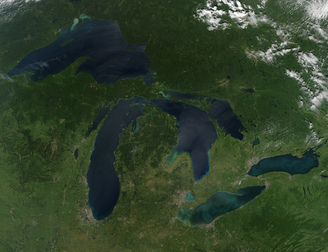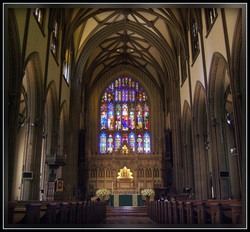About North America!

This is a photo of the Great Lakes, a major feature in North America!
North America has only two countries, which are recognized as the United States, and Canada.
Climate: Almost every climate exists within North America, ranging from Cool Humid climates, to Tropical wet/dry climates which is normally only found in the southern tip of Florida located in the United States. There is very cold Arctic climates located in the north of Canada. The majority of North America is consumed with a continental moist climate label all year round. Another major climate in North America is, moist all year around, subtropical with a dry winter, and a Mediterranean climate with a dry summer. There is also Desert climate in the mid to lower section of West in the United States.Most of the temperatures in Northern America are majorly influenced by the movement and interaction of the air masses with the landforms.
Major Features of North America: There are lots of Mountain Peaks in North America.
There is the "Rocky Mountain Zone" which ranges from western Canada south to Western United states and down through Mexico where it is known there as the "Sierra Madre".
There is also another Mountain region in North America, primarily in the East cost of the United States. This mountain range is known as the "Appalachian Mountains". These mountains where formed by early collisions of the North American Plate with North Africa thousands of years ago.
North America also has two major plates, North American Plate and the Pacific Plate (west coast). These two plates interactions are what causes most of the Earthquakes on the west cost of the United States.
In the middle of North America there is a Central Lowland, which is between the Rocky and Appalachian Mountain ranges. This was created bu the deposition of material that eroded from the mountains and where carried to the region by wind, rain, and the rivers.
The Mississippi drainage basin is a big part of the Central Lowland, and has a big part to play as well because it fertilizes the basins, and it can be kilometers deep.
Apart from the Central Lowland, North America also consists of a Coastal Lowland. It is intermittent and narrow in the North, but wider in the South. It stretches from New Brunswick to Florida and then West to the Gulf of Mexico. It has a major roll as well, consisting of the Mississippi Delta, which was formed by huge amounts of silt deposited by North America's largest river system; The Mississippi River. Another major feature in North America is the Great Lakes. Located in the middle of Northern United States. The Great Lakes, Lake Superior, Huron, Michigan, Eire, and Ontario, are the biggest source of fresh water in North America. They were formed over 2 million years ago by glaciers that picked up sediments. When the glaciers were melting, they would move, causing "souring", the depression that the Great Lakes formed in. Which leads us on to...
Climate: Almost every climate exists within North America, ranging from Cool Humid climates, to Tropical wet/dry climates which is normally only found in the southern tip of Florida located in the United States. There is very cold Arctic climates located in the north of Canada. The majority of North America is consumed with a continental moist climate label all year round. Another major climate in North America is, moist all year around, subtropical with a dry winter, and a Mediterranean climate with a dry summer. There is also Desert climate in the mid to lower section of West in the United States.Most of the temperatures in Northern America are majorly influenced by the movement and interaction of the air masses with the landforms.
Major Features of North America: There are lots of Mountain Peaks in North America.
There is the "Rocky Mountain Zone" which ranges from western Canada south to Western United states and down through Mexico where it is known there as the "Sierra Madre".
There is also another Mountain region in North America, primarily in the East cost of the United States. This mountain range is known as the "Appalachian Mountains". These mountains where formed by early collisions of the North American Plate with North Africa thousands of years ago.
North America also has two major plates, North American Plate and the Pacific Plate (west coast). These two plates interactions are what causes most of the Earthquakes on the west cost of the United States.
In the middle of North America there is a Central Lowland, which is between the Rocky and Appalachian Mountain ranges. This was created bu the deposition of material that eroded from the mountains and where carried to the region by wind, rain, and the rivers.
The Mississippi drainage basin is a big part of the Central Lowland, and has a big part to play as well because it fertilizes the basins, and it can be kilometers deep.
Apart from the Central Lowland, North America also consists of a Coastal Lowland. It is intermittent and narrow in the North, but wider in the South. It stretches from New Brunswick to Florida and then West to the Gulf of Mexico. It has a major roll as well, consisting of the Mississippi Delta, which was formed by huge amounts of silt deposited by North America's largest river system; The Mississippi River. Another major feature in North America is the Great Lakes. Located in the middle of Northern United States. The Great Lakes, Lake Superior, Huron, Michigan, Eire, and Ontario, are the biggest source of fresh water in North America. They were formed over 2 million years ago by glaciers that picked up sediments. When the glaciers were melting, they would move, causing "souring", the depression that the Great Lakes formed in. Which leads us on to...
Climate:

Every major type of climate on earth, except tropical wet exists here in North America. The landforms over this continental expanse contribute to its enormous climate variety by influencing the movement and interaction of air masses. The large size of the North America continent creates a wide variety of temperatures. In the continental interior, with hot summers and cold winters. Because the land heats up and cools off more rapidly than water, temperatures in the continental interior are hotter in the summer and colder in the winter than areas along the coast, where temperatures are moderated by the oceans. On the eastern side of the Rocky Mountains the main source of moisture is the Gulf of Mexico. When the continent is warming up in the spring and summer, the air masses above it rise, pulling in moist, buoyant air from the Gulf. This air interacts with cooler, drier, heavier air masses moving into the central lowland from the north and west, often creating violent thunderstorms and associated tornadoes. Generally, the central part of North America is wettest in the east and south and driest in the north and west.
Resources in North America:

The Great Lakes are one of the major resources in North America as
well. They consist of a huge amount of fresh water. Over 30 million
people live in the Great Lakes basin and depend on this fresh water
resource. Another major resource in North America is the Agriculture.
This occurs in almost all of the Middle section of North America as well
as some in the East. Agriculture ranges from: Mixed Farming, truck
crops, fruit, dairying, corn belt, cash grains, livestock, wheat, small
grain, range livestock, plantations, and general farming.
Technology:
There was a decline in Manufacturing Employment that changed by the
1960's. It was changed because of the labor union laws that increased
pay and benefits along with better work environments/conditions, and
they had to keep the equipment current. The raised cost started to cause
companies to move themselves elsewhere, first they moved to the
southwest, where the Labor Union Laws weren't in effect yet, but soon
enough factories were forced to move to places like Mexico and overseas
to places like China. Growth of the Service Sector came into play when
companies moves, meaning that manufacturing took a major decline in
North America and people were put into different jobs. 80% of people now
work in services like transportation, utilities, wholesales and retail
trade, health, leisure, maintenance, government and educational jobs.
Environmental Issues: With growing technology there's growing environmental issues as well. One of the major environmental issues North America is dealing with is Air Pollution. Air Pollution is caused from the growing in cities and production factories. Major area's that see a lot of pollution is the big cities, and West Coast, Seaside area. Air pollution causes the smog (which looks like dirty fog) in major cities, it also causes thermal inversion and sometimes when worse comes to worse, acid rain/snow.
Environmental Issues: With growing technology there's growing environmental issues as well. One of the major environmental issues North America is dealing with is Air Pollution. Air Pollution is caused from the growing in cities and production factories. Major area's that see a lot of pollution is the big cities, and West Coast, Seaside area. Air pollution causes the smog (which looks like dirty fog) in major cities, it also causes thermal inversion and sometimes when worse comes to worse, acid rain/snow.
Religion:Melting Pot

In Canada and the United States one is legally free to accept whatever religion one wants or none at all. This was caused because there were so many immigrants coming into North America, but most of which were Christian. Christianity is currently the biggest religion in North America, but don't be surprised if you come across Judaism, Islam, and even Buddhism. Roman Catholic remains in regions where Hispanic, French, Irish and Italian people have settled. Baptist and same Protestants normally more dominate in the south like Louisianan, and in Southwest parts of Canada. Mormons and Christians are the fastest growing groups. But even though there is a lot of different religion practices, there is a law that protects religion from interfering with decisions. Separation of the Church and State.
References:
Pulsipher,
L.M., and Pulsipher, A. (2008). World Regional Geography: Global Patterns,
Local Lives (4th ed.) Pages 53-114. New York: W.H. Freeman and
Company.
picture of tornadoes from: http://1.bp.blogspot.com/-sNWCeNQwC1g/Ta3ilNbu-1I/AAAAAAAAACM/PVuvsSXXUvc/s1600/tornadoDM3030a_800x533.jpg
picture of tornadoes from: http://1.bp.blogspot.com/-sNWCeNQwC1g/Ta3ilNbu-1I/AAAAAAAAACM/PVuvsSXXUvc/s1600/tornadoDM3030a_800x533.jpg
